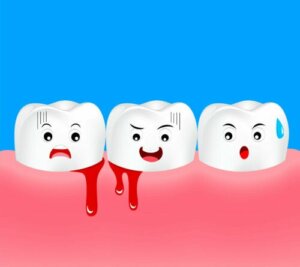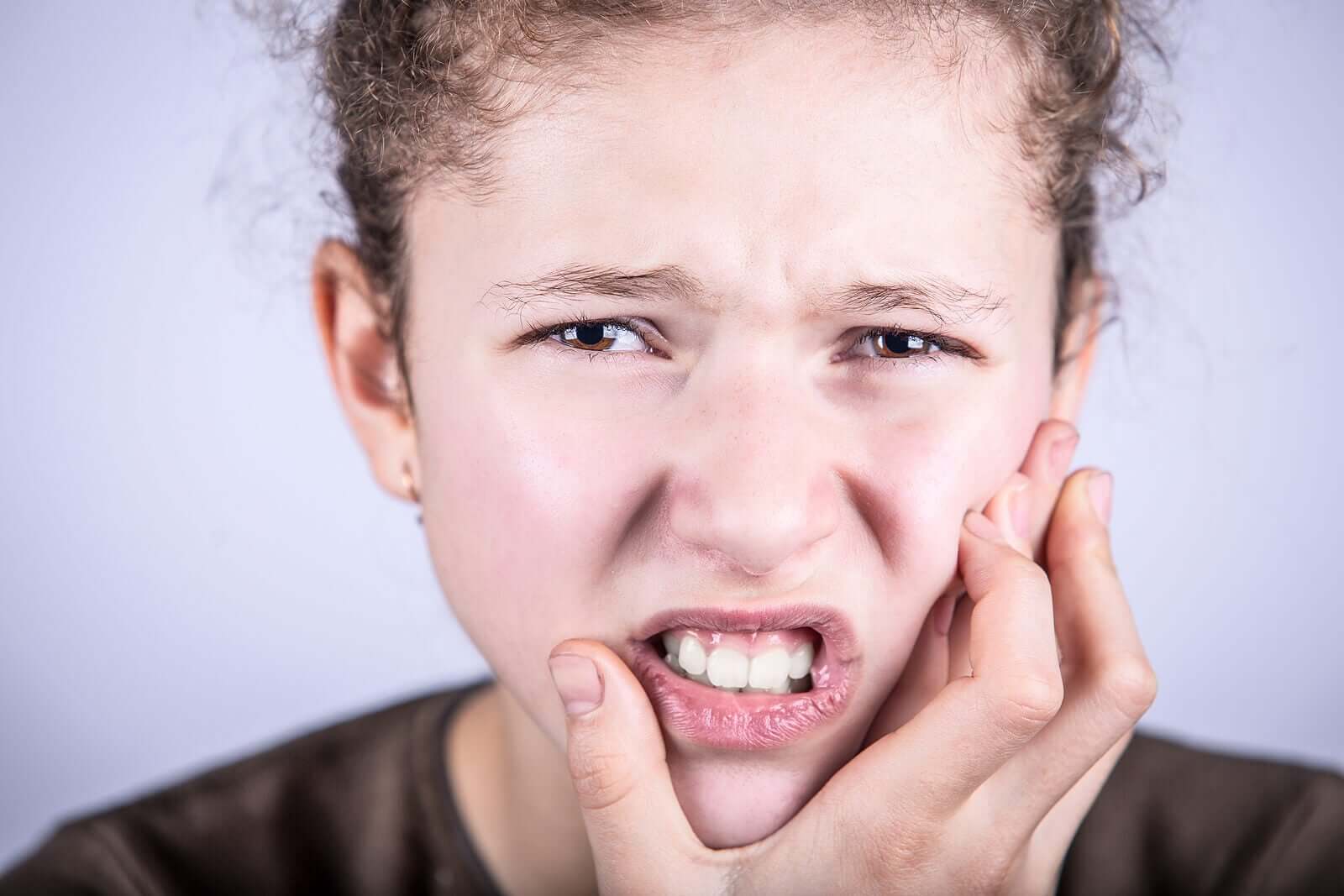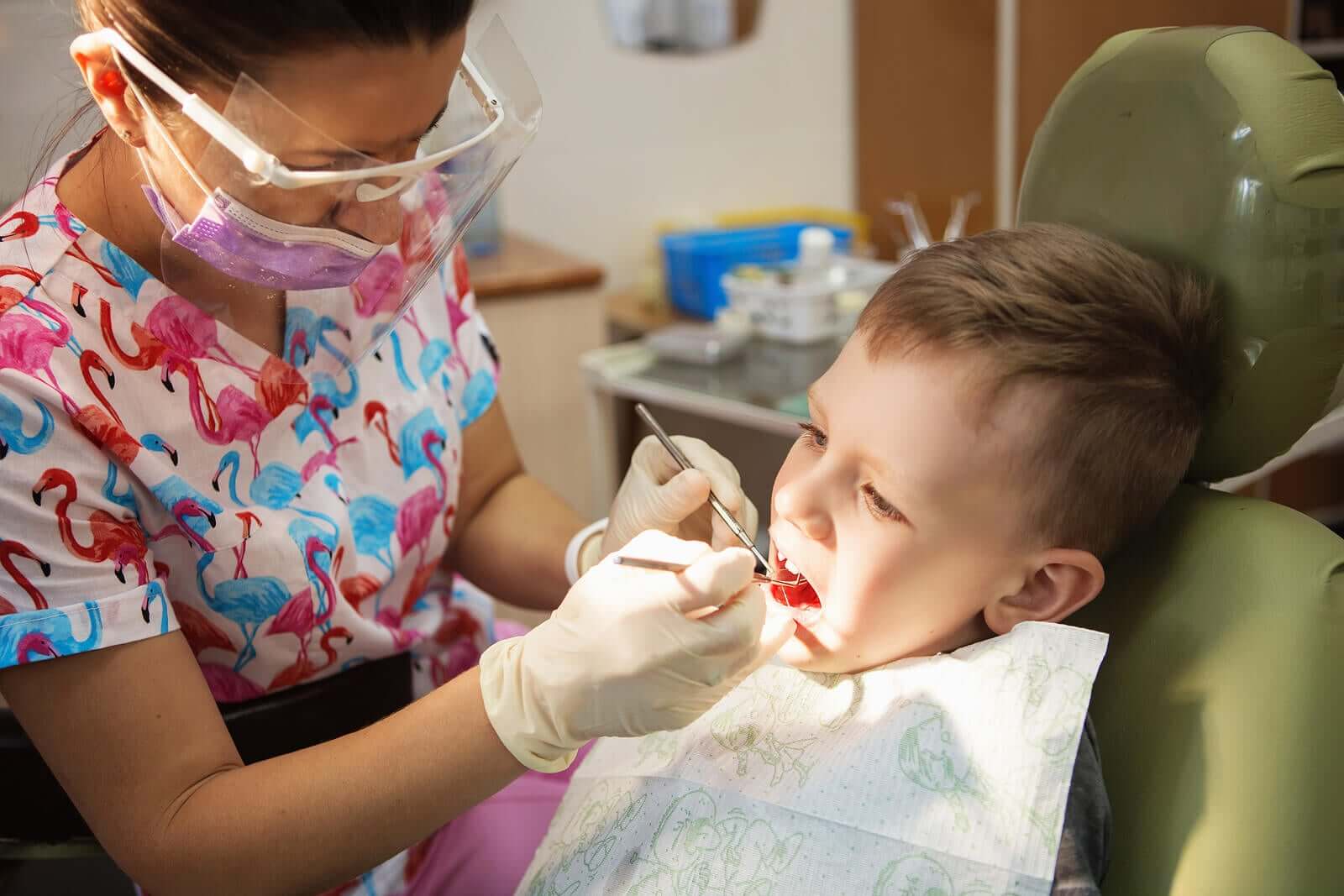Gingivitis in Children: Symptoms and Treatment

Gingivitis in children, or gum disease, is a disease that affects children’s gingival tissue. Although it’s more common in adults, it frequently appears in children as well. Generally, it’s a result of poor oral hygiene.
When you don’t brush your teeth properly, plaque builds up on your teeth and gums, causing them to become inflamed. If you don’t get rid of the bacteria, minerals from your saliva settle on it, transforming into tartar. Then, this further irritates the gingival tissue.
If left untreated, gingivitis can cause the loss of bone and supporting tissues of teeth, making the teeth move. In general, this situation doesn’t happen to kids, but it needs treatment anyway. Its symptoms are annoying, and plaque buildup on your teeth is associated with other diseases.
Parents play a fundamental role in teaching and practicing good oral hygiene habits. In this article, we’ll show you the symptoms and treatment of this disease. In addition, we’ll show you what you can do to prevent gingivitis in children.

Symptoms of gingivitis in children
Gingivitis in children causes the following symptoms:
- Inflammation: Red and swollen gums is the most noticeable symptom. It happens as a response from the gingival tissue to the buildup of bacteria.
- Bleeding: Gums bleed at the slightest contact with the gums from a toothbrush or food when eating. In fact, watching when children spit after brushing helps to recognize this common symptom.
- Bad breath: The accumulation of bacteria in the mouth causes a bad smell.
- Pain: This symptom of gingivitis in children isn’t permanent and varies from one child to another. It starts as a feeling of sensitivity, especially when touched.
- Abscesses: The appearance of pus and abscesses on the gums is a symptom that the disease is getting complicated, and a dentist needs to treat it immediately.
- Sensation of movement: With inflammation, teeth can start feeling like they’re separating or moving.
It’s a good idea for parents to be aware of these symptoms that may indicate gingivitis in children. For example, watching them when they brush their teeth can help you notice if there is blood.
Also, it can be helpful if you notice blood in the food that your children are eating. Seeing red debris in a bitten apple is a sign. Paying attention to the shape, color and thickness of the gums also helps you find any changes over time. If the gums are red and swollen, instead of the normal pink and smooth appearance, that’s a characteristic of this disease.
Treatment
The treatment of gingivitis in children is to control and eliminate the bacterial plaque that causes the irritation. When you notice this disease, it’s very important to start to improve your children’s oral hygiene routine.
They should brush their teeth after each meal, for at least two minutes, and with the correct technique. Additionally, it’s essential for the parents to commit to helping with this task.
Also, you need to make an appointment for a pediatric dentist. This professional evaluates the condition of the gums, and suggests the best treatment for each case.
Sometimes, you’ll need a professional cleaning, especially when there is plaque buildup. Regular visits to the dentist, every 6 months, helps to identify any problem early and resolve it immediately.
Tips to avoid gingivitis in children
Here are some tips to prevent bacteria from irritating your children’s gums:

- Brushing: Make sure to brush three times a day after every meal. Also, you can use a toothpaste with fluoride and a soft toothbrush to remove plaque.
- Teach and watch their brushing technique: You should explain and practice the correct tooth brushing technique with your children. Specialists suggest that you should divide the mouth into 4 quadrants and follow an order so you don’t forget any area. You need to clean on all sides of the teeth, brushing the tongue too.
- Use dental floss: Flossing after brushing helps get rid of plaque that builds up between your teeth.
- Rinse your mouth with mouthwash: Sometimes, the dentist might recommend using mouthwash. It’s important for your child to know when to use it and how to spit well.
- Motivate your kids: Turning brushing your teeth into a game or motivating them with songs, stickers or competitions can help make this routine fun. Setting an example at home and having children see that adults also take care of their oral health is the best motivation.
- Visit the dentist regularly: Taking your child at least twice a year for a general check-up helps detect any problems early.
In addition to everything we mentioned above, talking with your children about the importance of having a healthy mouth and the problems you avoid with proper oral hygiene is very important. You aren’t just preventing diseases like gingivitis in children, but also helping them to be responsible and careful with their own body.
Gingivitis in children, or gum disease, is a disease that affects children’s gingival tissue. Although it’s more common in adults, it frequently appears in children as well. Generally, it’s a result of poor oral hygiene.
When you don’t brush your teeth properly, plaque builds up on your teeth and gums, causing them to become inflamed. If you don’t get rid of the bacteria, minerals from your saliva settle on it, transforming into tartar. Then, this further irritates the gingival tissue.
If left untreated, gingivitis can cause the loss of bone and supporting tissues of teeth, making the teeth move. In general, this situation doesn’t happen to kids, but it needs treatment anyway. Its symptoms are annoying, and plaque buildup on your teeth is associated with other diseases.
Parents play a fundamental role in teaching and practicing good oral hygiene habits. In this article, we’ll show you the symptoms and treatment of this disease. In addition, we’ll show you what you can do to prevent gingivitis in children.

Symptoms of gingivitis in children
Gingivitis in children causes the following symptoms:
- Inflammation: Red and swollen gums is the most noticeable symptom. It happens as a response from the gingival tissue to the buildup of bacteria.
- Bleeding: Gums bleed at the slightest contact with the gums from a toothbrush or food when eating. In fact, watching when children spit after brushing helps to recognize this common symptom.
- Bad breath: The accumulation of bacteria in the mouth causes a bad smell.
- Pain: This symptom of gingivitis in children isn’t permanent and varies from one child to another. It starts as a feeling of sensitivity, especially when touched.
- Abscesses: The appearance of pus and abscesses on the gums is a symptom that the disease is getting complicated, and a dentist needs to treat it immediately.
- Sensation of movement: With inflammation, teeth can start feeling like they’re separating or moving.
It’s a good idea for parents to be aware of these symptoms that may indicate gingivitis in children. For example, watching them when they brush their teeth can help you notice if there is blood.
Also, it can be helpful if you notice blood in the food that your children are eating. Seeing red debris in a bitten apple is a sign. Paying attention to the shape, color and thickness of the gums also helps you find any changes over time. If the gums are red and swollen, instead of the normal pink and smooth appearance, that’s a characteristic of this disease.
Treatment
The treatment of gingivitis in children is to control and eliminate the bacterial plaque that causes the irritation. When you notice this disease, it’s very important to start to improve your children’s oral hygiene routine.
They should brush their teeth after each meal, for at least two minutes, and with the correct technique. Additionally, it’s essential for the parents to commit to helping with this task.
Also, you need to make an appointment for a pediatric dentist. This professional evaluates the condition of the gums, and suggests the best treatment for each case.
Sometimes, you’ll need a professional cleaning, especially when there is plaque buildup. Regular visits to the dentist, every 6 months, helps to identify any problem early and resolve it immediately.
Tips to avoid gingivitis in children
Here are some tips to prevent bacteria from irritating your children’s gums:

- Brushing: Make sure to brush three times a day after every meal. Also, you can use a toothpaste with fluoride and a soft toothbrush to remove plaque.
- Teach and watch their brushing technique: You should explain and practice the correct tooth brushing technique with your children. Specialists suggest that you should divide the mouth into 4 quadrants and follow an order so you don’t forget any area. You need to clean on all sides of the teeth, brushing the tongue too.
- Use dental floss: Flossing after brushing helps get rid of plaque that builds up between your teeth.
- Rinse your mouth with mouthwash: Sometimes, the dentist might recommend using mouthwash. It’s important for your child to know when to use it and how to spit well.
- Motivate your kids: Turning brushing your teeth into a game or motivating them with songs, stickers or competitions can help make this routine fun. Setting an example at home and having children see that adults also take care of their oral health is the best motivation.
- Visit the dentist regularly: Taking your child at least twice a year for a general check-up helps detect any problems early.
In addition to everything we mentioned above, talking with your children about the importance of having a healthy mouth and the problems you avoid with proper oral hygiene is very important. You aren’t just preventing diseases like gingivitis in children, but also helping them to be responsible and careful with their own body.
All cited sources were thoroughly reviewed by our team to ensure their quality, reliability, currency, and validity. The bibliography of this article was considered reliable and of academic or scientific accuracy.
- Murrieta Pruneda, José Francisco, et al. “Prevalencia de gingivitis en un grupo de escolares y su relación con el grado de higiene oral y el nivel de conocimientos sobre salud bucal demostrado por sus madres.” Boletín Médico del Hospital Infantil de México 61.1 (2004): 44-54.
- Angulo, Fiorella Puelles, et al. “prevalencia de gingivitis en niños de la escuela primaria jesús de nazareth caserío baldera san josé–2017.” Salud & Vida Sipanense 4.1 (2017): 15-19.
- Navarro Salazar, Carmen, María del Carmen Pareja Vásquez, and Luis Mariano Maita Castañeda. “Eficacia de la clorhexidina y del control mecánico en la reducción de gingivitis en niños de 10 a 12 años.” (2008).
- Chuchuca Mite, Givanna Doménica. Prevalencia de gingivitis en niños de 5 a 8 años de edad de la Escuela Coronel Luciano Coral de Guayaquil. BS thesis. Universidad de Guayaquil. Facultad Piloto de Odontología, 2019.
- Rocha Navarro, Miriam Lucía, et al. “Prevalencia y grado de gingivitis asociada a placa dentobacteriana en niños.” Nova scientia 6.12 (2014): 190-218.
- Martín, María Eugenia, and María Susana Discacciatti de Lértora. “Prevalencia de Enfermedad Gingival en niños con Dentición Primaria.” Revista de la Facultad de Odontología 4.1 (2011): 19-28.
- Castro-Rodríguez, Yuri. “Enfermedad periodontal en niños y adolescentes. A propósito de un caso clínico.” Revista clínica de periodoncia, implantología y rehabilitación oral 11.1 (2018): 36-38.
- Sullca Suni, Fiorely Frinee. ““Evaluación De Higiene Oral Y Su Relación Con La Gingivitis En Niños De 6 A 9 Años Que Acuden A La Clínica Odontológica De La Universidad Andina Néstor Cáceres Velásquez, Juliaca 2019”.” (2020).
This text is provided for informational purposes only and does not replace consultation with a professional. If in doubt, consult your specialist.








